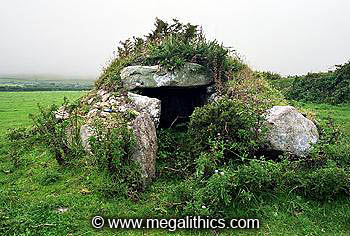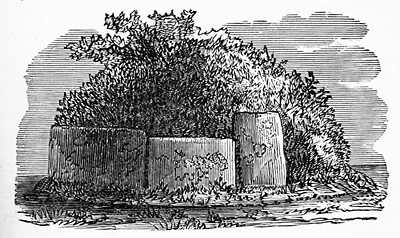
 |
Photo Gallery |
|
Panoramas & Spin-o-rama |
||
| SW 40134 28193 (GPS 30min). | Dia. 4.7m (approx.) |
| Visited August 2001 |
The megalithic tomb at Brane stands in pasture land about 2km WSW of Sancreed, it is a type of monument known as an Entrance Grave. These are unusual tombs with a very restricted distribution, they are found only in the Scilly Isles and the very tip of Cornwall, click here for a overview of the Entrance Grave class as a whole.

The engravings on this page
are all from Borlase (1).
Borlase (1) writes that the Chapel Euny Barrow (Brane), "was first
discovered by the author in the month of April, 1863" while he was
"exploring a subterranean structure about a quarter mile distant"
(this was probably the Carn Euny fogou).
He correctly identifies Brane as being of similar construction to the Pennance
Entrance Grave, which he had visited previously.
Brane is mentioned by Hencken (2) in his definition of the Entrance Grave class in 1932, and is listed by Daniel (3) in 1950 as one of the four definite mainland Entrance Graves known at that time.
Although Brane appears to be in an excellent state of preservation compared to ruinous
state of Treen and Tregeseal, there is more to the story than meets the eye. In 1982 Brane was
described as being one of the best preserved chambered tombs in Britain, but only seven years later it had suffered "one of the worst cases of erosion in all of
Cornwall", kerbstones were missing and the mound material had been displaced by livestock. By 1995 the tomb had been repaired by the addition of new granite kerbs and the re-forming of the
mound. We could not find any detailed accounts of the extent of the restoration, so our description is based on the monument as it
appeared during our visit in
2001.
At first glance Brane resembles a small earth-covered hut, it is only when you notice the huge stones used in its construction that it becomes apparent that this is a megalithic tomb.
With a maximum diameter of just under 5 metres, Brane is a small example of its type, the majority of Entrance
Graves measuring between 6m and 12m across.
The mound is composed of earth and stones and seemed to be slightly oval in plan, it
appeared to have a smooth domed profile that was effectively concealed during our visit by a luxuriant "top-knot" of vegetation growing
from the upper section. Whether this profile is original is unknown because of the re-forming carried out during
restoration, Borlase's drawings seem to suggest a more rounded shape.
The mound is retained by a ring of heavy, contiguous kerbstones, these are of pink and grey granite and, with one exception, all lie
horizontally. Only one kerb at the rear of the tomb was set upright and this is the tallest stone at the site,
the stone is also shown upright in one of Borlase's engravings, so this is
probably an original feature. We noticed a run of four stones on the eastern side of the tomb that seemed slightly smaller than the rest of the
kerbs, we have no way of telling if this original size grading, or simply the result of restoration.

Entrance to the chamber is through an intentional gap in the kerbs, this outer section of the chamber was probably unroofed and forms a kind of passage. The western side slab of the passage abuts the chamber side-slab proper and neatly projects out to the very edge of the kerb ring. The front section of the passage on the eastern side was obscured by
thick vegetation during our visit but there appeared to be an obvious gap between the chamber side-slab and the final kerb, we wondered if a passage side-slab was missing here.
The chamber consists of two large rectangular side slabs with a small back slab
between and two large lintel-like roofstones sitting on the upper edges of the side slabs. Packing stones seem to have been used between the rear roof stone and the back edge of the eastern side-slab. This type of "box"
chamber construction with large slabs is very different to the dry stone walling we saw employed in
another well preserved Entrance Grave at Pennance, while the part-ruined example at
Tregiffian used a mixture of both types of construction. A
typical feature of Entrance Graves is that their chambers extend into the mound
well past the centre point, at Brane this trait is taken to the extreme with a
3.7m long passage in 4.7m diameter cairn.

The ?extensive kerb and mound restoration cause a problem in identification of the chamber type
today. Daniel (3) speculates that a third roofstone may have extended the
chamber to the very edge of the kerb and places Brane in category D of his
chamber classification scheme. We noticed that the surviving outer western
side-slab was set at quite an angle to the inner slab, if an outer side slab
existed in a parallel position on the eastern side, it would mean that the
chamber was not straight. Unfortunately for this theory there are no outer side
slabs at all shown on Borlase's plan of 1872, if this is accurate, it means that
the western side of the entrance is a modern reconstruction.
Of the eight mainland Entrance Graves that we have visited so far, Brane has the best combination of chamber access and mound preservation (albeit restored). Or, in the words of Borlase " It may fairly be considered as the most perfect of its kind in the West of England. "
1. Borlase W.C., Naenia Cornubiae 1872
Longmans.
2. Hencken H., The Archaeology of Cornwall and Scilly, 1932
Metheun.
3. Daniel G.E., The Prehistoric Chamber
Tombs of England and Wales, 1950 Cambridge University Press.